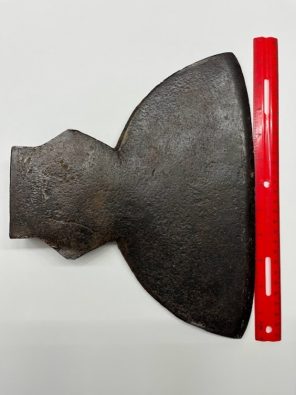The foundation you see in front of you was for the tempering, grinding, polishing, and handle fitting shops. The forge shop is the foundation you see across the creek. The dam was directly to your right.
There were a variety of different axe-heads produced at the axe factory.
Felling axe – What you typically think of an axe to look like but made in different sizes including small hatchets. It has a double bevel edge with both sides of the edge being sharpened at an angle.
Double bit axe – There are two cutting edges, and the handle is in the middle. One edge finely sharpened for felling. The other edge is thicker and not as sharp thus making it more durable.
Adze – The edge is perpendicular to the handle. It is used to smooth out the surface of rough-cut wood.
Blood Battle Axe – 20-inch curved blade (sharpened on the inside of the curve) shaped like a brush hook and polished to a mirror finish

Broad axe (Hewing axe) – pictured below. It has a long straight blade. One side of the edge is flat while the other side of the edge is beveled. This is known as a single bevel edge. It is used to shape logs into flat sided beams.
(Starr, 2010, pp. 49, 56)
Author’s photos of a hewing axe courtesy of the Crandall Public Library
A Blood broad (hewing) axe-head is available to view at the Crandall Public Library in Glens Falls. It cannot be removed from the Folklife Center. The single bevel edge of this blade measures 11 ¼ inches. It is 9 ¼ inches from the edge to the poll. The hole for the handle measures 1 inch by 2 ½ inches.
The documentation provided courtesy of the Crandall Public Library reads as follows:
The axe head is stamped:
BLOOD
[Illegible – should be BALLSTON] N.Y.
CAST ST___ (Some axes were stamped “CAST STEEL”)
Page researched and created by Parker Duthaler for his Eagle Scout Project (November 12, 2023)

